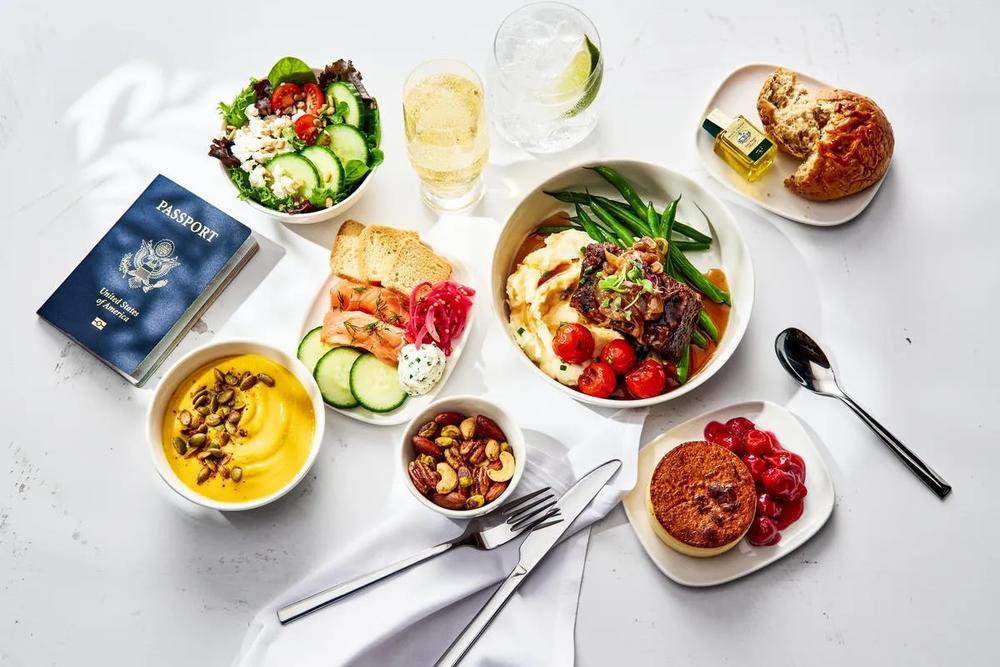
Caption
A past meal option for Delta One customers flying internationally included beef short rib from Fox Bros. Bar-B-Q.
Credit: Provided by Delta Air Lines

A past meal option for Delta One customers flying internationally included beef short rib from Fox Bros. Bar-B-Q.
The act of flying to another country is almost as exciting as being there. For Atlantans preparing for an overseas flight, you arrive at Hartsfield-Jackson International Airport extra early. It’s the world’s busiest airport and getting through security can take time, especially on peak travel days.
Traveling internationally out of Hartsfield-Jackson also means perusing the duty-free shops in Concourses E and F to pass the time before your flight. Maybe you hit the Delta Sky Club lounge or the new Centurion Lounge on Concourse E.
Once on board, there’s unwrapping the airline’s complimentary baggie of toiletries with its essential eye mask for sleeping and the promise of stunning views from the window seat when you wake up of the ocean, the Alps, or tiny towns and villages dotting the countryside as you near your destination.
Then there’s the food served on an international flight. It’s an integral part of the flying experience.
While domestic flights typically serve packaged snack foods, eating on a long-haul flight often includes a full meal or two. Depending on the cabin class you’re flying in, meals may come with real silverware, glassware, and a cloth napkin.
Meals on international flights have reached a new level of innovation, too, as airline culinary programs must juxtapose food safety, special diets, and allergies with a degree of creativity.
Gategroup North America’s kitchen in Hapeville prepares most meals for international flights departing from Hartsfield-Jackson. The group solely prepares meals for airlines such as Air France, Qatar Airways, and Turkish Airlines.
In Hapeville, roughly 200 employees prepare up to 5,000 meals daily for international flights. Passengers receive multiple meals during their time in the air. Chefs and cooks transform enormous cans of pantry staples like beans and ketchup and massive blocks of Parmesan cheese into meals. (Fun fact: Gategroup goes through an average of 50 pounds of carrots a day.)
The Hapeville facility is one of nearly 160 Gategroup locations in the United States and Canada, says Jens Kuhlen, president for North America at Gategroup. “We are essentially serving every single airline in the world.”
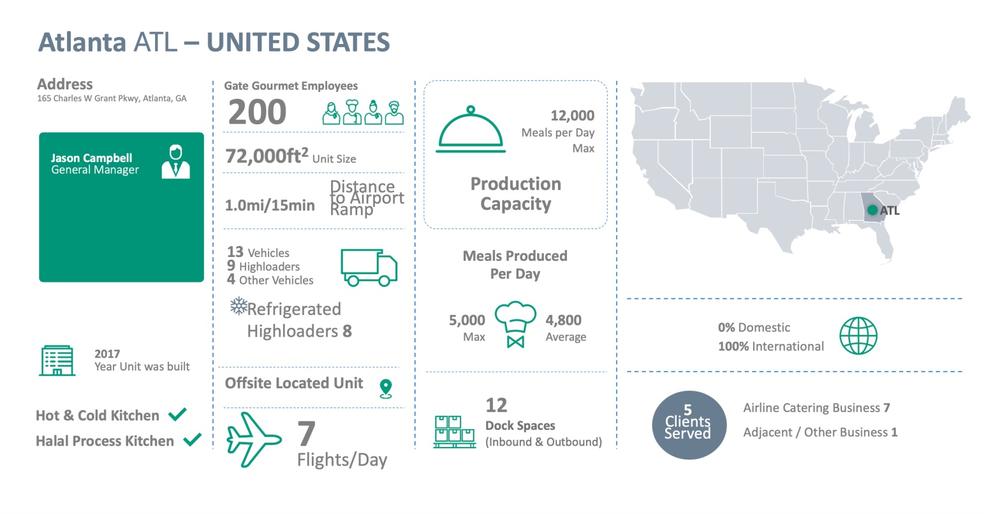
Gategroup North America fact sheet on Atlanta.
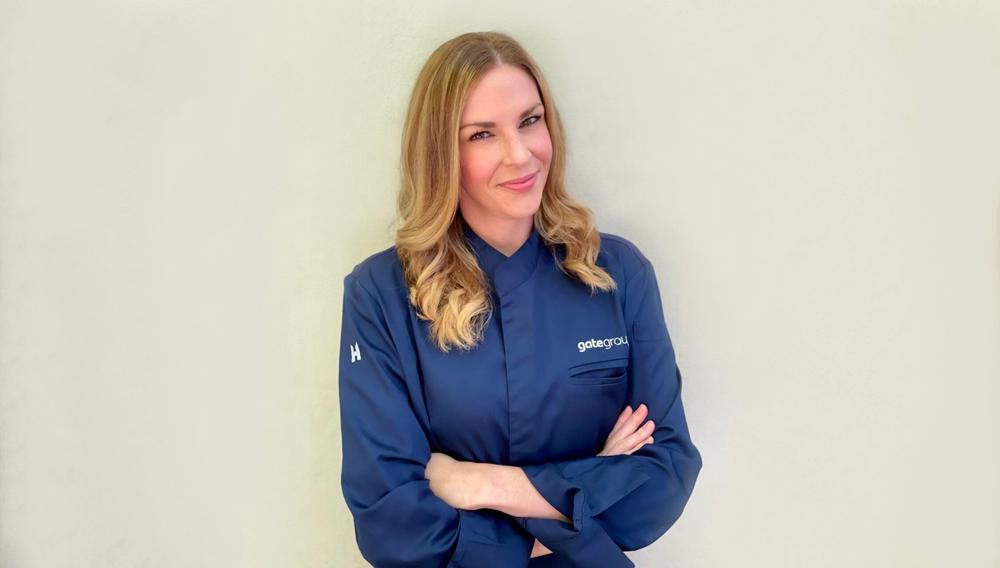
Molly Brandt, Gategroup North America’s executive chef for innovation.
Gategroup and airline groups like Delta and Air France have three layers of chefs. The highest level includes executive chefs such as Molly Brandt, Gategroup North America’s executive chef for innovation. She conceptualizes in-flight meals.
At the second level, design chefs, known as dedicated airline chefs, draft menus from Brandt’s ideas for various meal cycles throughout the year.
The third level encompasses the executive chef and executive cook team in every unit, where the day-to-day operations occur.
“Everything designed at the first two levels is then executed by the third on a daily basis,” Kuhlen says.
Brandt calls herself a dreamer and takes a multilayered approach to creating meal cycles for various airlines. Each airline and the routes, along with passengers and their departure hub, help Brandt come up with specific meals and menu ideas.
For Atlanta, she determines the American viewpoint of an international passenger coming in or out of Hartsfield-Jackson.
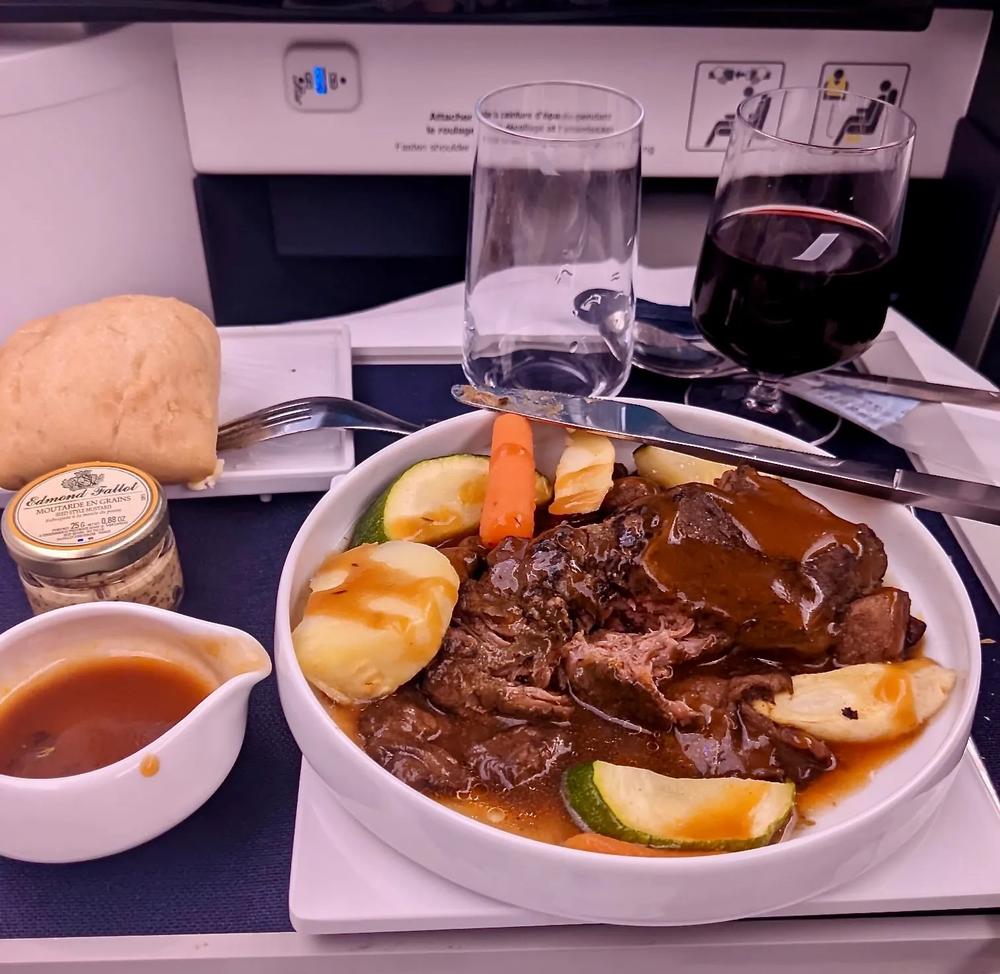
An example of First Class cabin dinner service on Air France.
“When you’re doing something like an international flight and you have to create a menu for let’s say, three cycles, so three parts of the year, and you have four different cabin classes and you have multiple meal periods within that [flight time]. It can be hundreds of different things,” she says. “It’s very difficult to continue to come up with something fresh.”
In addition to researching deep dives on international dishes, Brandt contacts friends from around the world and asks questions like, “What are the things your mom made?” or “What do you miss eating on the street?” This research manifests into dishes like pork al pastor served with hominy grits, grilled pineapple, and sliced tomatillos and jalapenos or Coca-Cola glazed meatloaf topped with dry carrot and red cabbage slaw.
Due to her high-level position at Gategroup as an executive chef, Brandt doesn’t deal with an airline’s special meal program for passengers with specific food allergies or dietary needs based on medical history or religious background. A separate team handles those particular meals.
Gategroup isolates allergens and special diet meals away from its regular meal production kitchen in Hapeville. For example, the group sequesters its Halal flight production area behind a floor-to-ceiling fence to avoid contamination of ingredients.
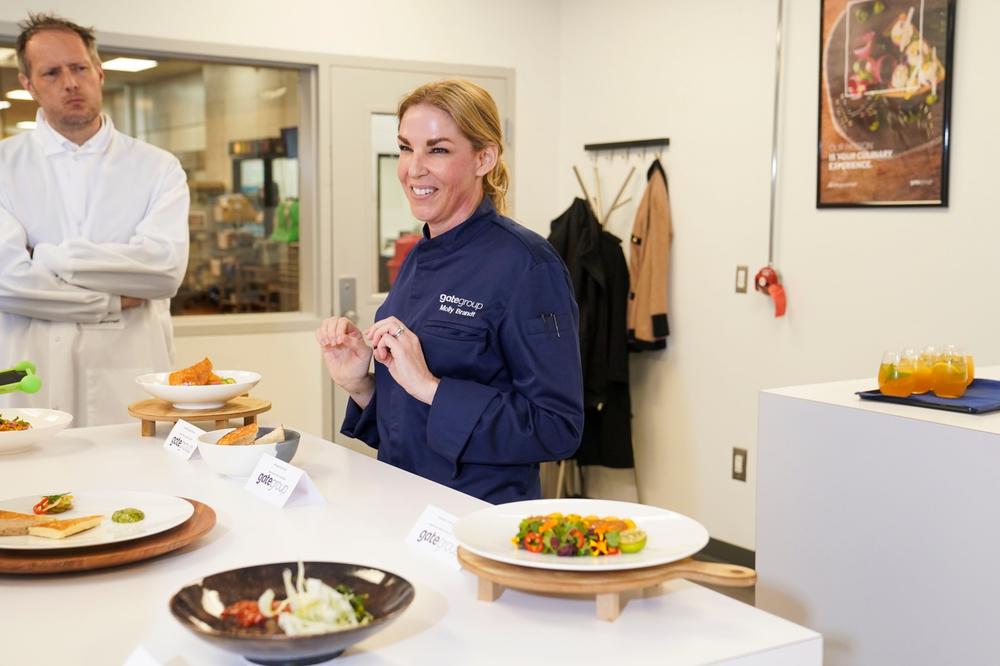
Chef Molly Brandt conceptualizes international in-flight meals for Gategroup North America.
Brandt does take into consideration, however, the most common dietary restrictions and allergies at the request of an airline when composing meal cycles. She keeps extremely detailed notes.
“If the airline says ‘We don’t want sesame,’ or ‘we cannot,’ then we won’t create anything with that [ingredient] and I’ll provide a substitute,” she says.
But Brandt will always include a vegetarian or vegan meal option, a lamb-based protein choice, and a pescatarian meal for flights.
Like Gategroup, Atlanta-based Delta Airlines prepares international flight meals out of a separate kitchen from its domestic routes.
According to a Delta spokesperson, the International Flight Kitchen requires a collaborative team to prepare more than 24,500 meals daily, surpassing 171,000 weekly. General trends and data from meal preferences from hundreds of thousands of flights and post-flight customer surveys help shape international flight menus.
The culinary team for Delta’s international flight kitchen plans meals ahead of time, with premium passengers (Delta One and Delta Premium Select) pre-selecting their meals on most routes before they arrive at the airport. The culinary team then prepares meals six to 12 hours before loading onto a flight. Depending on a meal’s delicateness and serving temperature, some meals need reheating or require earlier preparation.
Delta’s Onboard Services team and Culinary Council determine what local ingredients and products to serve on flights. Passengers might sip on canned cocktails from Atlanta-based beverage company Tip Top or dine on tortellini from Marietta-based pasta wholesaler Pasta Mami.
Delta’s Onboard Services team sources products, while the Culinary Council, a group of chefs and food-service specialists, regularly collaborates with Delta’s internal culinary team. Delta’s Culinary Council also discusses local produce and product sourcing and evaluates passenger feedback with the internal culinary team.

James Beard award-winning chef Mashama Bailey of The Grey in Savannah collaborated on the latest Delta One menu.
In addition to ingredients, the Culinary Council affects how Atlanta- and Georgia-based chefs design menus. James Beard award-winning chef Mashama Bailey of The Grey in Savannah recently designed a menu for international Delta One passengers departing from Atlanta offering an open-faced short rib sandwich and a smoked chicken salad created by popular Atlanta barbecue restaurant Fox Bros. Bar-B-Q.
Special meals, including options for vegetarian, low-cholesterol, and diabetic diets, are available on all international Delta flights. The international kitchen team prepares Hindu meals, for example, without meat and limits the use of dairy products, while kosher meals come prepared by kosher caterers under rabbinical supervision.
As the world’s busiest airport, the number of passengers flying in and out of Hartsfield-Jackson daily averages around 286,000 people. While not all of the flights departing Hartsfield-Jackson are international, for those that are, the combined efforts of Gategroup and Delta come close to producing 30,000 meals a day for these passengers.
Keeping meals interesting, safe, and accessible requires hundreds of airline food service workers, who create, cook, and portion out meals for hundreds of international and long-haul flights on a daily basis.
If you equate this large-scale meal preparation to the world’s biggest catering gig, it’s like feeding a small city every single day.
This story comes to GPB through a reporting partnership with Rough Draft Atlanta.